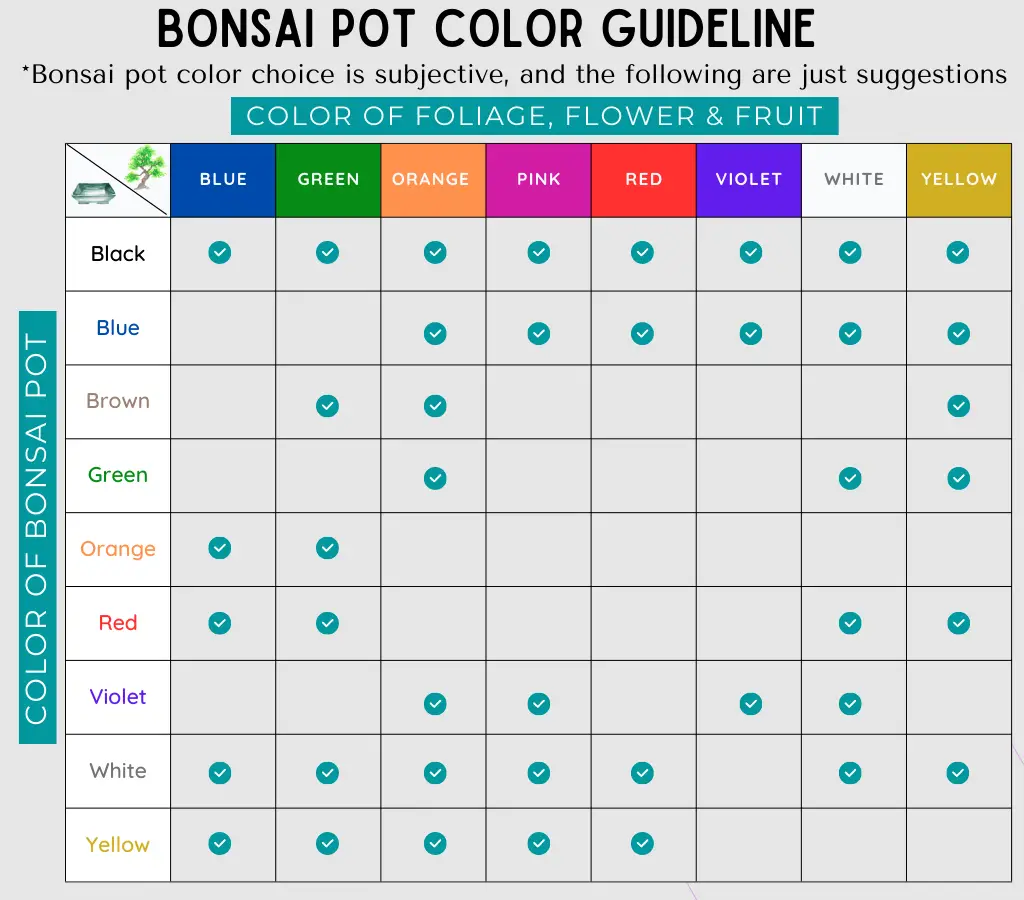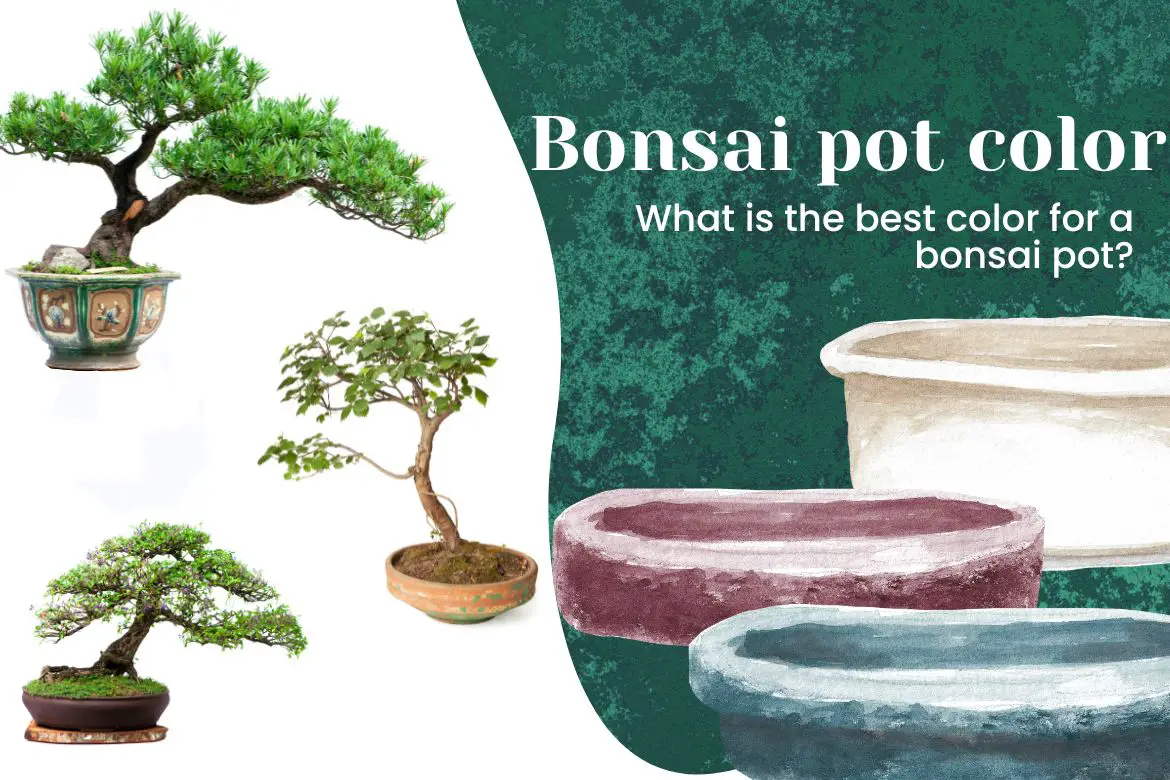Bonsai pots are designed to complement the bonsai. The color and texture of the bonsai pot plays a crucial role in enhancing the aesthetics of all types of bonsai tree. Flower and foliage colors come in a variety of colors, and hence bonsai pots also come in a variety of colors to complement them.
What is the best color for a bonsai pot?
There is no one “best” color for a bonsai pot, as the choice of color ultimately depends on personal preference, color of the trunk and the leaves, the tone of the flowers and fruits and the overall aesthetic that you want to achieve.
Bonsai pots in the past were usually brightly colored, painted or even in bas-relief (pot with sculpted figures), however today’s trend is towards softer colors and plainer lines.
There are some guidelines that you can follow while selecting the color of your bonsai pot. Please remember that color choices are subjective, and the following guidelines are merely suggestions:

- As a first recommendation, choose a pot that doesn’t dominate the plant. Larger pots are usually subdued in color and texture to avoid dominating the tree. However, a smaller bonsai pot can be brighter.
- Pots with bright colors, bright glazes, or heavy patterns will distract attention from the tree itself and disrupt the composition’s harmony.
- By and large, selecting the color of the bonsai pot is a matter of personal taste. By experimenting with different containers for the same bonsai tree, you can see how different pots can affect its appearance.
- For evergreens and conifers, unglazed pots that are brown, reddish brown, or gray in color are typically used.
- It is best to use glazed containers in deep or pastel shades for flowering and fruiting bonsai species. The pot should enhance the plant’s predominant colors. In order to balance the powerful effects of a flowering bonsai in full bloom, a pot of vibrant color is needed. However, some bonsai enthusiasts also recommend using more subdued and subtle colors. Color selection depends on your taste and experience. In any case, avoid really bright colors and high-gloss glazes. Consider the color of the flowers and try to complement them. Azaleas are an exception to this rule, since they are treated as non-flowering bonsai in terms of pot selection.
- Japanese maples or zelkovas, with delicate foliage, look attractive in pots with subdued pastel glazes. Elms (Chinese elm bonsai & Japanese elm bonsai), serissas, azaleas (satsuki azalea bonsai & sims azalea bonsai) and dark-leaved deciduous trees can be planted in a pot with deeper color.
- Junipers (California juniper bonsai, Meyers Juniper bonsai, Needle Juniper bonsai, Common Juniper bonsai, Sargent Juniper bonsai, Chinese Juniper bonsai) and yews (Japanese Yew bonsai, & Chinese Yew bonsai), with their striking chestnut-red bark, look stunning in subtle beige, brown or ‘burnt-earth’ colors with a matte, unglazed finish.
- Pine bonsai trees (Italian stone pine bonsai, Australian Pine bonsai, Mugo pine bonsai, Scots pine bonsai, Japanese white pine bonsai, Japanese black pine bonsai, Aleppo pine tree bonsai) with their vibrant green needles and dark, rough bark are enhanced by pots that are rich brown or deep red in color.
Should bonsai pots be glazed or unglazed?
Selecting a glazed or unglazed depends on the type of bonsai tree. Unglazed pots are generally used for evergreens and conifers. While glazed pots are typically used for flowering and fruiting bonsai trees. However, the choice also depends on your personal preference.
Glazed bonsai pots are generally more expensive than unglazed pots.
Unglazed pots, also known as “terra cotta” or “clay” pots, are porous and allow for better air circulation and water absorption. This can be beneficial for bonsai trees that require good drainage and aeration, as well as those that prefer a drier soil environment. Unglazed pots also have a natural, earthy look that can complement the appearance of many bonsai trees.
Glazed pots, on the other hand, are coated with a layer of glaze that can provide a protective barrier against moisture loss and help retain soil moisture. This can be useful for bonsai trees that require a consistently moist environment, such as those that are native to humid or tropical regions.
Glazed types are better able to withstand wet and cold conditions when left outside and acquire an attractive patina that softens their color. There are some bonsai enthusiasts who consider this aging an enhancement of the container, while there are others who prefer their indoor bonsai to have a more cleaner appearance, rather than one resembling the outdoors.
Glazed pots can also come in a variety of colors and finishes, allowing for more color and design options.
Why are bonsai pots not glazed inside?
Bonsai pots with glazed interiors are generally not recommended. There are a few reasons why bonsai pots are not glazed from inside:
- Better grip for the roots: Unglazed parts of the clay pot have a slight rough texture. As a result of this rough texture, the roots are able to grip the pot more effectively and help in stabilizing the tree. Furthermore, if the inside of the bonsai pot is glazed, the soil will also be unable to adhere to the inside of the pot, which could then cause soil movement.
- Waste of material: The inner side of the bonsai pot is not visible. Hence glazing the inside of the bonsai pot is waste of time, money and material.
- Better drainage and water absorption: When water is poured into a pot with a glazed interior, the water may accumulate on the surface of the glaze or be absorbed more slowly, which can lead to waterlogged soil and increases the possibility of root rot. The unglazed interior of a bonsai pot allows for better water absorption and drainage, as water can move freely through the porous material and out of the drainage holes in the bottom of the pot.
- Better aeration: Additionally, an unglazed interior can help maintain a more consistent soil moisture level by allowing excess water to evaporate through the porous material. This can help prevent overwatering and promote healthy root growth.
In some cases, bonsai pots may be partially glazed or have a decorative glaze applied to the exterior of the pot while the interior remains unglazed. This can provide some protection against moisture loss while still allowing for adequate drainage and aeration.

